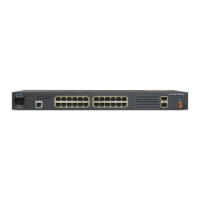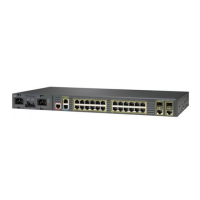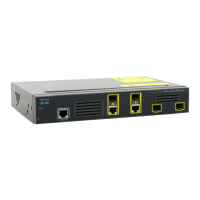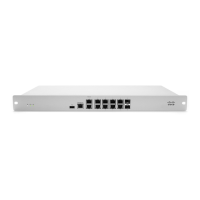11-19
Cisco ME 3400 Ethernet Access Switch Software Configuration Guide
OL-9639-07
Chapter 11 Configuring VLANs
Configuring VLAN Trunks
Configuring the Native VLAN for Untagged Traffic
A trunk port configured with IEEE 802.1Q tagging can receive both tagged and untagged traffic. By
default, the switch forwards untagged traffic in the native VLAN configured for the port. The native
VLAN is VLAN 1 by default.
Note The native VLAN can be assigned any VLAN ID.
For information about IEEE 802.1Q configuration issues, see the “IEEE 802.1Q Configuration
Considerations” section on page 11-15.
Beginning in privileged EXEC mode, follow these steps to configure the native VLAN on an
IEEE
802.1Q trunk:
To return to the default native VLAN, VLAN 1, use the no switchport trunk native vlan interface
configuration command.
If a packet has a VLAN ID that is the same as the sending port native VLAN ID, the packet is sent
untagged; otherwise, the switch sends the packet with a tag.
Configuring Trunk Ports for Load Sharing
Load sharing divides the bandwidth supplied by parallel trunks that connect switches. To avoid loops,
STP normally blocks all but one parallel link between switches. Using load sharing, you divide the traffic
between the links according to the VLAN to which the traffic belongs.
You configure load sharing on trunk ports that have STP enabled by using STP port priorities or STP
path costs. For load sharing using STP port priorities, both load-sharing links must be connected to the
same switch. For load sharing using STP path costs, each load-sharing link can be connected to the same
switch or to two different switches. For more information about STP, see
Chapter 14, “Configuring STP.”
Command Purpose
Step 1
configure terminal Enter global configuration mode.
Step 2
interface interface-id Define the interface that is configured as the IEEE 802.1Q trunk, and
enter interface configuration mode.
Step 3
no shutdown Enable the port, if necessary. By default, UNIs and ENIs are disabled
and NNIs are enabled.
Step 4
switchport trunk native vlan vlan-id Configure the VLAN that is sending and receiving untagged traffic
on the trunk port.
For vlan-id, the range is 1 to 4094.
Step 5
end Return to privileged EXEC mode.
Step 6
show interfaces interface-id switchport Verify your entries in the Trunking Native Mode VLAN field.
Step 7
copy running-config startup-config (Optional) Save your entries in the configuration file.

